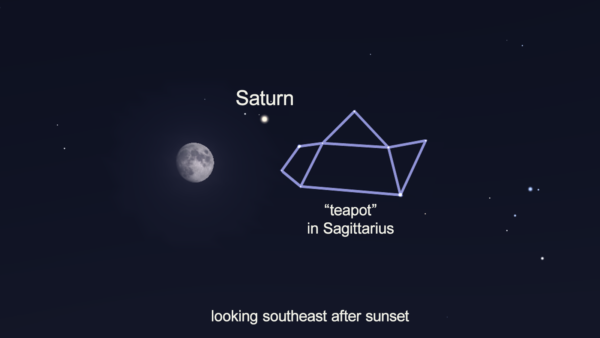Look For Saturn And The Teapot Plus Meteors
Last week, it was Jupiter cozying up to the Moon, tonight Aug 12, it’s Saturns turn, just 6 degrees away from the nearly full Moon rising in the southeast. Thought the rest of this week, the Moon will move about 10 degrees eastward each evening but Saturn will stay right beside another sight worth taking a look at the teapot in Sagittarius.
Look for a triangle of stars on top forming the lid, two trapezoids forming the body and handle and another triangle pointing upward forming the spout. The tip of the spout points right into one of the brighter portions of the milky way, our galaxy. From particularly dark areas, the north-westerly arc of the milky way looks a bit like steam rising off the teapot.
The teapot is an asterism. Other asterisms you may already know to include the big dipper in the constellation Ursa Major (the Great Bear) and Little Dipper formed by the brightest stars of the constellation Ursa Minor (the little bear). The great square is formed by the body of Pegasus.
Asterism, a recognizable pattern formed by stars, and while that sounds a lot like the definition of a constellation, an asterism isn’t exactly a constellation. Asterisms are smaller and usually found within constellations. The summer triangle even spans the Aquila, Cygnus, and Lyra constellations. And while probably even more popularly known, asterisms aren’t official like the constellations.
The scientific community, specifically the International Astronomical Union, adopted the set of modern constellations at their meeting in 1928. Made up of 42 animals, 29 inanimate objects and 17 humans or mythological characters, the 88 constellations serve as neighborhoods in the sky that astronomers use as a reference, initially to aid in the naming of new stars
When you are outside, turn to the North and you might catch a Perseid meteor or two. Normally one of the most active meteor showers of the year with dozens of meteors visible under good conditions, this year most meteors will likely be lost in the bright moonlight. The best time to see meteors will be tomorrow morning, August 13 between about 4:30 and 6:30 am local time, after moonset and before sunrise.
Category: ALL POSTS, Spacey Stuff
















